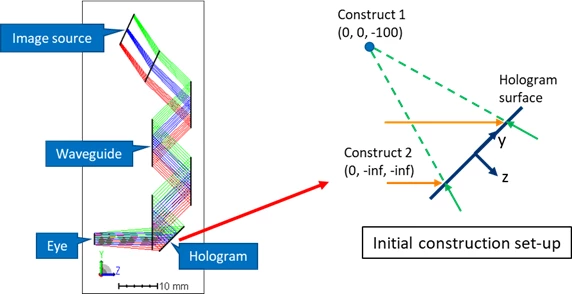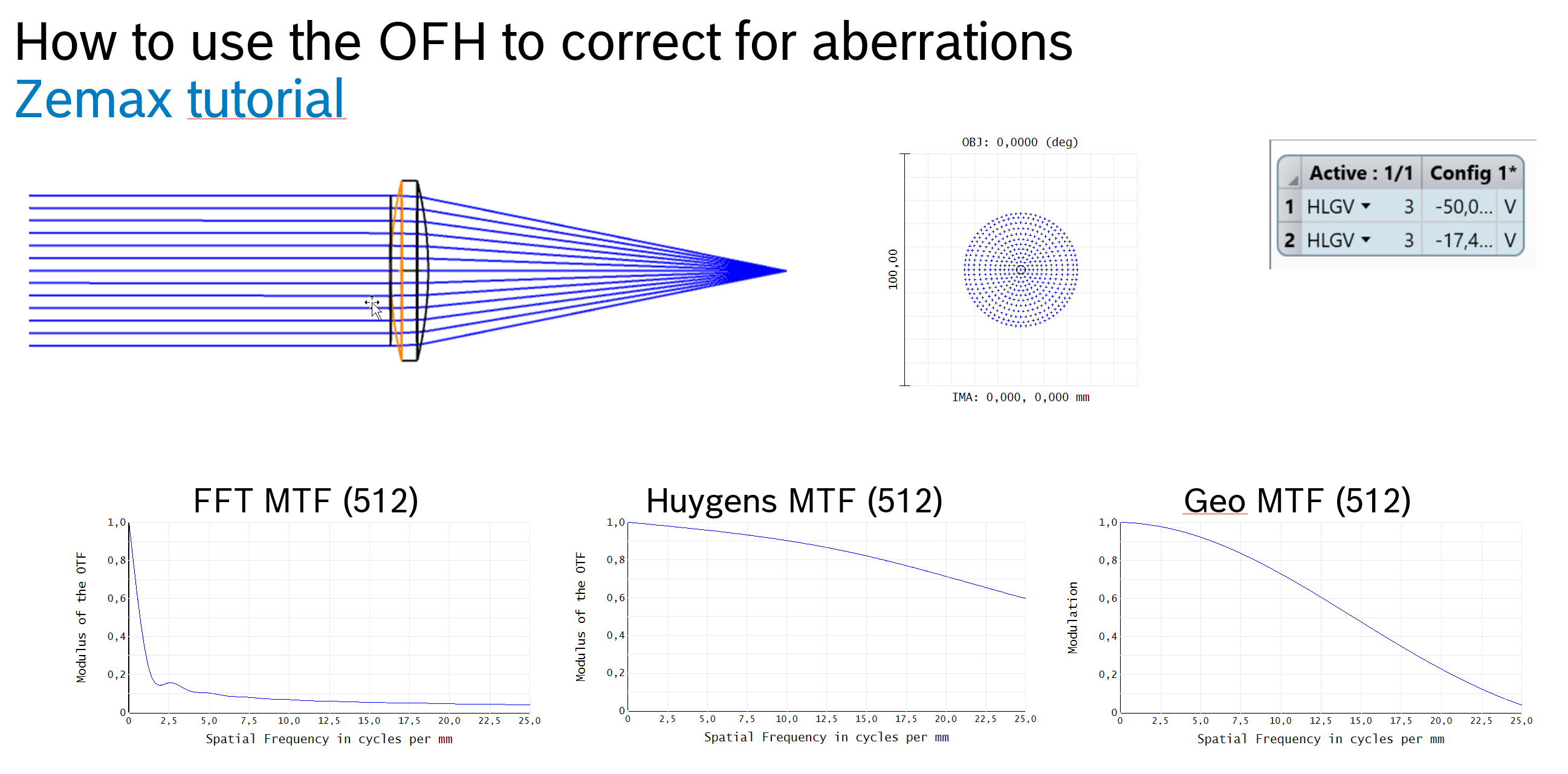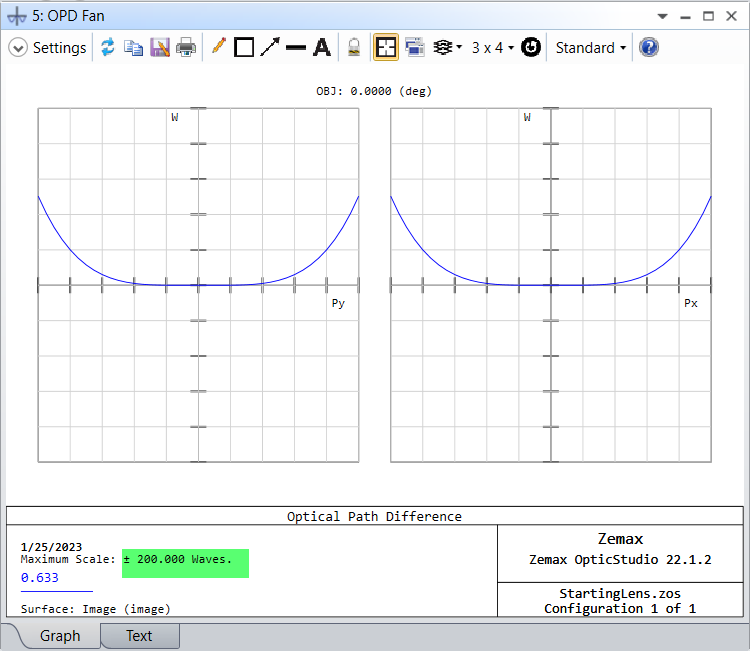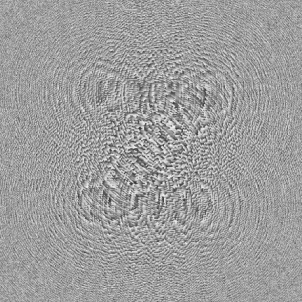Update 2021-09-24
This forum thread is answer some frequently asked questions about the volume hologram model in OpticStudio.
In OpticStudio 21.1, we have implemented volume hologram model for these sequential surfaces: Hologram 1, Hologram 2, Toroidal Hologram, Optically Fabricated Hologram.
This allows users to analyze the diffraction efficiency with give material information. More infomraiton can be found in Help file in OpticStudio 21.1 and this knowledge base article: Simulating diffraction efficiency of a volume holographic grating using Kogelnik’s method
1. Can I make the hologram with any kind of user defined shape?
When we say surface shape, it could be the substrate or the aperture. Here we will talk about both.
The shape of substrate only supports Standard (conic sphere), Toroidal (cylinder), Extended Polynomial (freeform) for now, but we can investigate if users request more.
If more shape of substrate are needed, except sending a feature request to Zemax product team, the fastest way to get it is by coding your own DLL as a plugin to OpticStudio.
On the other hand, you can also cut the substrate with any user defined aperture. For example, users can define an arbitrary polygon and use it as the aperture shape for the holographic surface.
2. Is this hologram model accurate compared to real hologram?
The algorithm we used for diffraction efficiency is based on Kogelnik's paper. It will be inaccurate if the hologram is not thick or if the index modulation is too large. Some more details to the limitation of the algorithm can be found in the following article link.
Simulating diffraction efficiency of a volume holographic grating using Kogelnik’s method
3. Can I use this model to simulate for so-called diffractive optical element (DOE)?
Hologram is just one special type of general DOEs. We actually rarely call hologram by DOE. For how “DOE” or “metalens” is usually simulated, it’s suggested users to check the following article.
How to design DOE lens or metalens in OpticStudio
4. What are the main limitation of holograms compared to other types of flat optics? Efficiency/quality drop due to shrinkage and/or index modulation?
This is a good question. Compared to surface-relief grating (SRG), I guess hologram is more limited to the choice of the material. Although SRG is also limited to some common material, however, SRG can be multi layers. You can combine several materials and achieve some special performance that you need.
One good example is the so-called resonant waveguide grating, which has special behavior that hologram is hard to achieve. Also hologram is very unique in terms of manufacturing method. It's built by interfering two beams on the emulsion and then developing it. SRG, on the other hand, is based on some methods that is also common in other science field.
5. Can I define a chirped hologram in OpticStudio?
Yes, if you mean the structure like in this paper (https://doi.org/10.1364/AO.44.004874). That should be no problem. You just need to correctly set up the coordinate of the two points for the construction beams. And the ray-tracing should give the correct result as described in Fig3 in that paper.
6. Can you define a circularly polarized hologram
This kind of hologram is based on anisotropic material. Unfortunately, our current model does not support anisotropic material yet. To support this, an update to the algorithm is needed. Please contact support@zemax.com if that’s important to your team.
7. Can you tell more about the effect of shrinkage on image quality?
The shrinkage is basically a change to the hologram's thickness. It will not change the diffraction beams’ propagation direction, but will change the required incidence angle and the wavelength for the peak diffraction efficiency. You can also check Fig 4 in the following article for a diagram showing what I meant by thickness change by shrinkage.
Simulating diffraction efficiency of a volume holographic grating using Kogelnik’s method
8. How to define the wavefront to be diverging or converging when setting up the hologram construction points?
If both construction points are converging or diverging points, you should choose the sequential surface “Hologram 1” or set the parameter Holo Type to 1 if you use other hologram surface type or object type.
If one of the construction point is diverging point and the other is converging, then you should use sequential surface Hologram 2 or the set the Holo Type to 2 for other hologram surface and object.
One common confusion is then why both converging and both diverging belong to same surface type when Holo Type = 1, or why we don't need to specify exactly which is diverging and which is converging when Holo Type = 2. The reason is we actually constructing the exactly same hologram is you reverse the two construction beams at the same time.
You can find more explanations in this article: Simulating diffraction efficiency of a volume holographic grating using Kogelnik’s method
Feel free to send an email to support@zemax.com if you still have any doubt!
9. Are there any examples of systems with Optically Fabricated Hologram on your website?
You can find some more tips in this community post: FAQ of Optically Fabricated Hologram (OFH): how to parameters Holo type and Diffract order
10. Is this the same procedure for Computer Generated Holograms?
Although Computer Generated Hologram (CGH) has a “hologram” in its name, it’s actually not manufactured by two beam interferences that our model assumes.
However, you can simply simulate a CGH with phase surfaces, such like Bianry 2 or Zernike Standard Phase. The two surfaces are very common used for designing for a phase plate for applications such like CGH.
11. Is it possible to add optically fabricated hologram into non-seq mode. With diffraction efficiency calculation.
This is a good question. We also had several requests from users about this. For now we cannot promise when this can be implemented, but Zemax product/development team do is aware of this request.
12. Do the diffraction efficiency take into account the beam power profiles of each beam?
The diffraction efficiency core only considers plane wave as input and output. If you have a beam that has finite size and thus finite divergence, and you want to simulate the diffraction efficiency accurately with this situation, I would build a source model with required divergence w/ required power distribution in angular space. Then the diffraction efficiency of this source should give you the diffraction efficiency considering the beam power profile. Please feel free to contact support@zemax.com if you have further doubt about this.
13. Can I simulate a hologram on cylinder surface?
Yes! That is what Toroidal hologram is supposed to provide. You can use Torodial Hologram to simulate a hologram coated on a cylindrical substrate.
14. How to simulate the MTF degradation cause by hologram?
Users can build a hologram model and just calculate MTF same as other normal systems. For fully optimizing the hologram with all possibility, you can use Optically Fabricated Hologram (OFH). Feel free to contact us if you think this doesn’t work for your case.
15. Is there any plan to implement for multiplexed hologram?
This is a good question. We have several same requests from users. Internally, we have a prototype based on the following paper, but it's quite unstable and need testing and debugging. I'm sorry it's not available for now. Please do not hesitate to let me know if you have any questions or concerns about this.
GLYTSIS, Elias N.; GAYLORD, Thomas K. Rigorous 3-D coupled wave diffraction analysis of multiple superposed gratings in anisotropic media. Applied optics, 1989, 28.12: 2401-2421.
Please also find our report about comparing this method and Kogelnik in this paper.
Han-Hsiang Cheng, Xiaochaoran Tian, "An advanced ray-tracing model for multi-color holographic optical elements," Proc. SPIE 11188, Holography, Diffractive Optics, and Applications IX, 1118817 (18 November 2019); https://doi.org/10.1117/12.2537762
16. What happens to the hologram model with polarized incident light?
This model considers polarization exactly. The diffraction efficiency will be change with different polarizations. In some special cases, the TM polarization will even have zero efficiency. Our hologram model can correctly consider this with no problem.
17. Is it possible to create a hologram that corrects for chromatic aberration?
That should be no problem. If I do this, I will set up the hologram with low optical power and first set it up only for single wavelength. Then you can introduce multiple wavelengths and optimize the construction beam data. If it's a symmetric system, you only need to optimize Z1 or Z2 or both.
18. How do you calculate the efficiency for the hologram model? RCWA?
The efficiency calculation is based on Kogelnik method. The most common RCWA is not a good algorithm for hologram because it decompose grating into several slices that is uniform in z direction. This is not needed for hologram and is inefficient.
19. I don’t see the parameter “Volume Hologram?”.
This is a new feature that is implemented in OpticStudio 21.1 and 21.2.
20. How the hologram and CGH are different from each other. How can one design a CGH for optical metrology application using OpticStudio.
The hologram we talked here is mainly constructed by two-beam interference. On the other hand, the computer generated hologram (CGH) is constructed in totally different way. CGH doesn't rely on two beam interference. CGH is made exactly by building microstructures on the surface. Roughly to say, CGH is even more flexible when you designing the phase profile, but its diffraction efficiency may not be as good as traditionally optically fabricated hologram.
To simulate CGH in OpticStudio, you should use Binary 2 or Zernike Standard Phase. They allow you to arbitrarily design for the phase profile.
21. Can the Optically Fab Hologram use the Kogelnik DE calculation?
Yes, of course!
22. Does OpticStudio have RCWA as an alternative to Kogelnik?
RCWA is designed for surface-relief grating. It's possible but not suggested to use RCWA for hologram simulation. Kogelnik is a more efficient and suitable algorithm for hologram diffraction efficiency calculation.
23. Will OpticStudio let you know if your hologram parameters (i.e. thickness) are outside of the volume hologram regime (Q parameter in which Kogelnik is applicable)?
This is a good question. Unfortunately, we didn't do this check internally, but that is possible and I will feedback this internally.
24. Can Hologram be used to simulate and calculate a diffraction grating efficiency, perhaps the diffraction grating has a sinusoid or a triangular groove profile?
In that case, it's called surface-relief grating and we have another algorithm called RCWA to handle. See the following article for more information!
Simulating diffraction efficiency of surface-relief grating using the RCWA method
25. Can the hologram model exactly handle the electric field in the light?
Yes! The diffraction efficiency calculation do consider the polarization state, which is the E-field (Exr, Exi, Eyr, Eyi, Ezr, Ezi) you meant.
26. Why is the parameter 'Shrinakge' seems not affecting anything?
If we look at only 'ray-tracing', the shrinkage doesn't not chagne anything. This parameter mainly changes the diffraction efficiency.
This is because the implementation of this parameter is by changing the hologram's thickness. If we separate the fringe period into two components that are vertical and parallel to normal vector as below, chagne of thickness means the change to the parallel component. On the other hand, the diffract ray's direction is decided by the vertical components. Therefore, shrinkage is not change diffraction direction becuase it only change parallel component and ray-tracing thorugh hologram is based on vertical component.
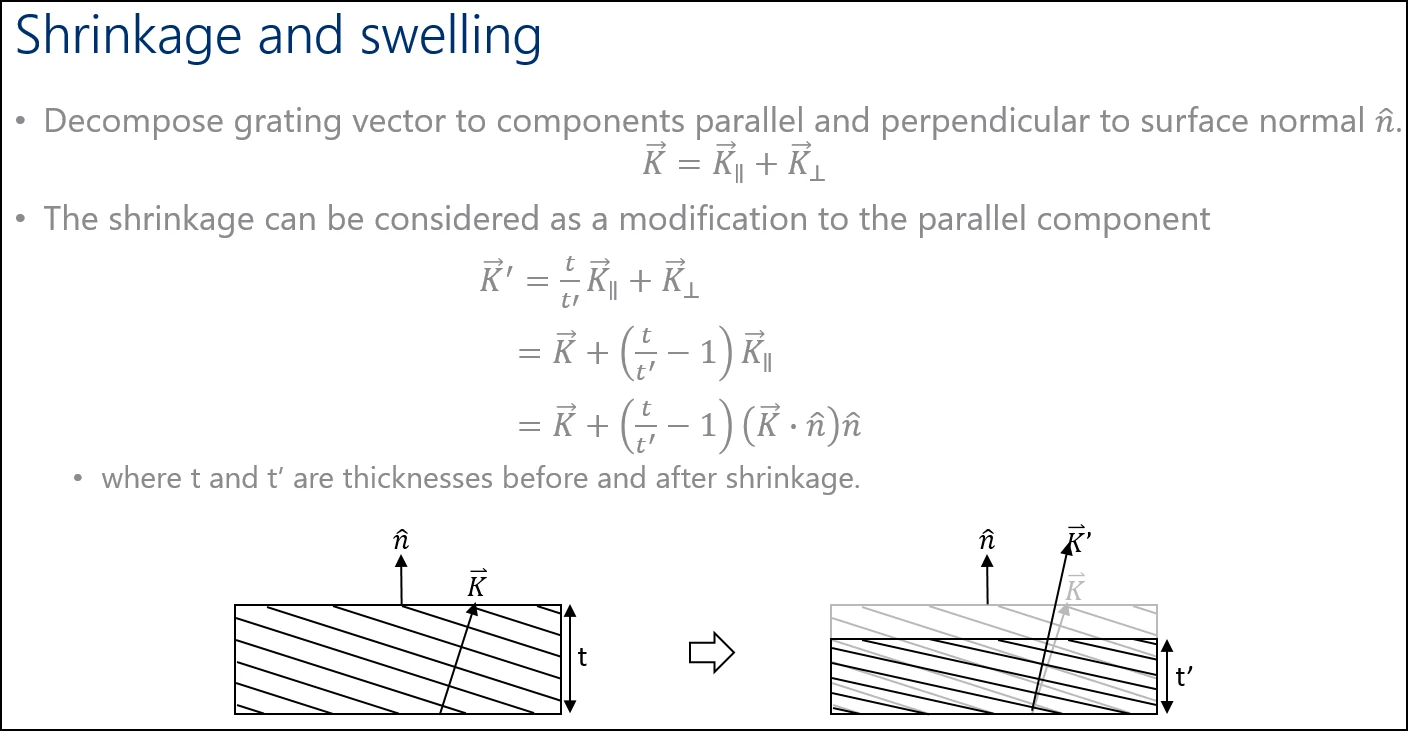
If more information is desired about why only vertical component is used, the follwoing paper describes the ray-tracing equation and should useful for further investigation.
WELFORD, W. T. A vector raytracing equation for hologram lenses of arbitrary shape. Optics Communications, 1975, 14.3: 322-323.
For an example how shrinkage changes the diffraction efficienc, see the following reference.
Han-Hsiang Cheng and Xiaochaoran Tian 'An advanced ray-tracing model for multi-color holographic optical elements', Proc. SPIE 11188, Holography, Diffractive Optics, and Applications IX, 1118817 (18 November 2019); https://doi.org/10.1117/12.2537762
27. Why is the ray-tracing different after using volume hologram
This is a result of Kogelnik's model. Ideally, when a ray hits the hologram, it can be diffracted into several orders, like 0, -1, +1, -2, +2, -3, +3, ...etc. However, in practice, the volume hologram has a working order, which is either -1 or +1. The power of incident order will be either coupled to working order or just directly pass through hologram as the 0th order. In Kogelnik's model, we assume only working order and 0th order exist. This working order is sometime -1 and somtimes +1, which depends on the incident ray's angle and the fringe direction. Note this is not user-definalbe. No matter -1 or +1 is set for 'Diffract Order' parameter, the diffraction order ray will always go direction of 'working order'.

In following reply, a 'demo_working_order1.zar' is attached for demo. In the file, a Hologram 2 is constructure by two beam sources (0,0,100) and (0,0,-100). there are 5 configurations. Each config has different object thickness.
As can be seen in the layout, the config 3 and 4 are similar but show very different behaviors. This is becuase they are at a boundary that working order switches from -1 to +1.
Note this is physical, but not artifact. When the hologram is thicken (volume hologram), the diffraction efficiency will natually be concentrated in eirther working order or 0th order.
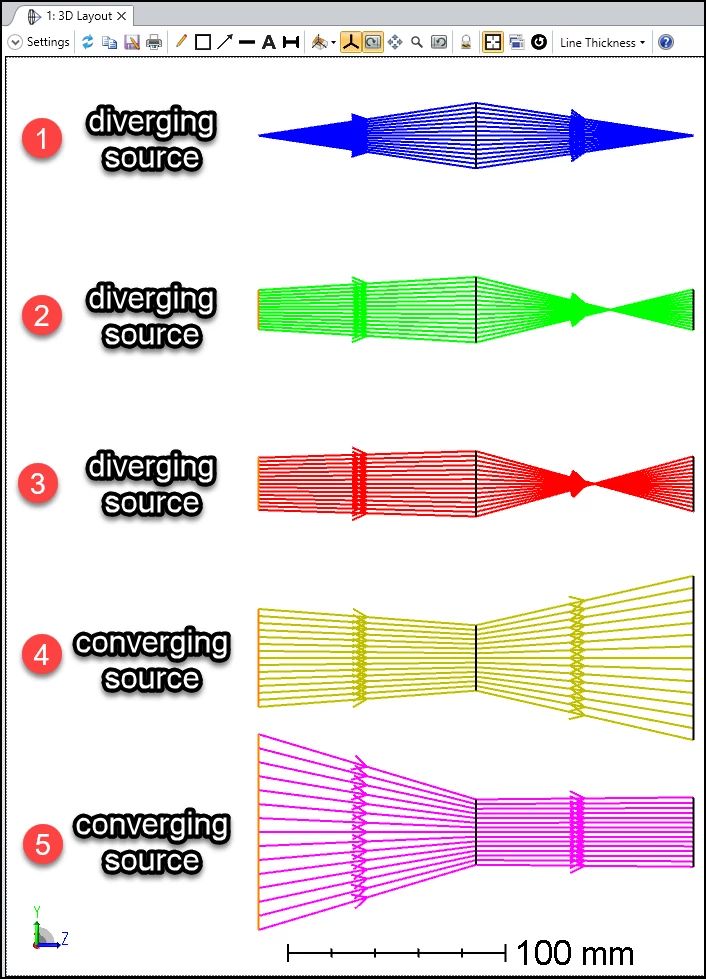
In following reply, a 'demo_working_order2.zar' is attached for another demo. As shown in layout, when the volume hologram is used, its result is mixed of Diffract Order -1 and +1 in idealized hologram.
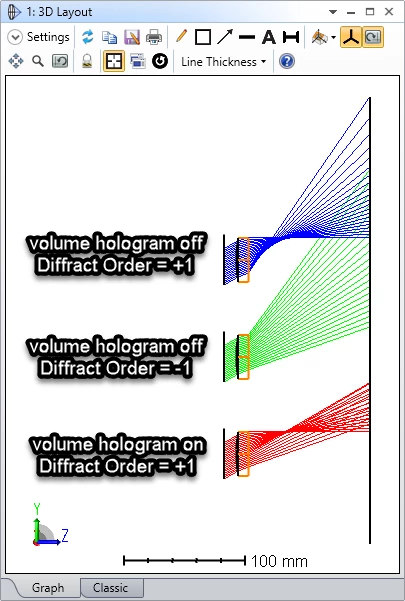
28. So how should I set it up. It's hard to make it work...
We suggest you set the hologram by considering how you want it works!
For example, if you have a beam that is virtually focusing at (y=100,z=100), but you want this hologram to steer this beam and instead focus it at (y=30,z=-100), then you should set beam1=(x=0,y=30,z=-100) and beam2=(x=0,y=100,z=100). The hologram type should be 1 because both incident and diffract beams are converging beam. It's same in the case where both beams diverge. If one diverge and another one converge, then we should use hologram 2.
Note beam 1 and 2 can be exchanged. This is not difference when volume hologram is used. However, for idealized hologram, exchanging beam1 and beam2 setting sometimes means the diffract order changes from +1 to -1 or -1 to +1. It's easier to just test to find whether -1 or +1 will work.
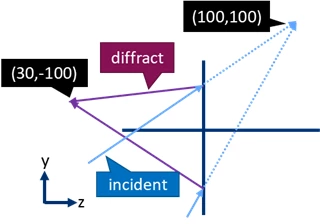
Another very nice example of setup systems is in this article: Modelling a holographic waveguide for Augmented Reality (AR) systems
In this article, we want a 45-degree collimated beam being focused at (0,0,-100). Then we set beam1=(0,0,-100) and beam2=(0,-1e8,-1e8) and use hologram 2 becuase one beam converge to (0,0,-100) and one beam diverge from infinity (0,-1e8,-1e8).
